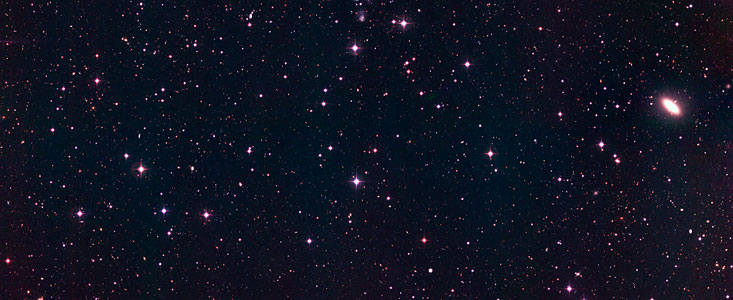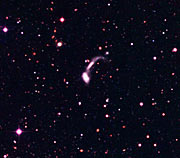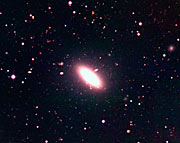Press Release
The Capodimonte Deep Field
A Window towards the Distant Universe
10 April 2001
The Osservatorio Astronomico Capodimonte Deep Field (OACDF) is a multi-colour imaging survey project that is opening a new window towards the distant universe. It is conducted with the ESO Wide Field Imager (WFI) , a 67-million pixel advanced camera attached to the MPG/ESO 2.2-metre telescope at the La Silla Observatory (Chile). As a pilot project at the Osservatorio Astronomico di Capodimonte (OAC) [1], the OACDF aims at providing a large photometric database for deep extragalactic studies, with important by-products for galactic and planetary research. Moreover, it also serves to gather experience in the proper and efficient handling of very large data sets, preparing for the arrival of the VLT Survey Telescope (VST) with the 1 x 1 degree 2 OmegaCam facility.
The Capodimonte Deep Field
With the comparatively few large telescopes available in the world, it is not possible to study the Universe to its outmost limits in all directions. Instead, astronomers try to obtain the most detailed information possible in selected viewing directions, assuming that what they find there is representative for the Universe as a whole.
This is the philosophy behind the so-called "deep-field" projects that subject small areas of the sky to intensive observations with different telescopes and methods. The astronomers determine the properties of the objects seen, as well as their distances and are then able to obtain a map of the space within the corresponding cone-of-view (the "pencil beam"). Recent, successful examples of this technique are the "Hubble Deep Field" and the "Chandra Deep Field" (eso0106).
In this context, the Capodimonte Deep Field (OACDF) is a pilot research project, now underway at the Osservatorio Astronomico di Capodimonte (OAC) in Napoli (Italy). It is a multi-colour imaging survey performed with the Wide Field Imager (WFI), a 67-million pixel (8k x 8k) digital camera that is installed at the 2.2-m MPG/ESO Telescope at ESO's La Silla Observatory in Chile.
The scientific goal of the OACDF is to provide an important database for subsequent extragalactic, galactic and planetary studies. It will allow the astronomers at OAC - who are involved in the VLT Survey Telescope (VST) project - to gain insight into the processing (and use) of the large data flow from a camera similar to, but four times smaller than the OmegaCam wide-field camera that will be installed at the VST.
The field selection for the OACDF was based on the following criteria:
- There must be no stars brighter than about 9th magnitude in the field, in order to avoid saturation of the CCD detector and effects from straylight in the telescope and camera. No Solar System planets should be near the field during the observations;
- It must be located far from the Milky Way plane (at high galactic latitude) in order to reduce the number of galactic stars seen in this direction;
- It must be located in the southern sky in order to optimize observing conditions (in particular, the altitude of the field above the horizon), as seen from the La Silla and Paranal sites;
- There should be little interstellar material in this direction that may obscure the view towards the distant Universe;
- Observations in this field should have been made with the Hubble Space Telescope (HST) that may serve for comparison and calibration purposes.
Based on these criteria, the astronomers selected a field measuring about 1 x 1 deg 2 in the southern constellation of Corvus (The Raven). This is now known as the Capodimonte Deep Field (OACDF). The above photo (ESO Press Photo eso0116a) covers one-quarter of the full field (Subfield No. 2 - OACDF2) - some of the objects seen in this area are shown below in more detail. More than 35,000 objects have been found in this area; the faintest are nearly 100 million fainter than what can be perceived with the unaided eye in the dark sky.
Notes
[1] The team members are: Massimo Capaccioli, Juan M. Alcala', Roberto Silvotti, Magda Arnaboldi, Vincenzo Ripepi, Emanuella Puddu, Massimo Dall'Ora, Giuseppe Longo and Roberto Scaramella .
[2] This is a preliminary result by Juan Alcala', Massimo Capaccioli, Giuseppe Longo, Mikhail Sazhin, Roberto Silvotti and Vincenzo Testa , based on recent observations with the Telescopio Nazionale Galileo (TNG) which show that the spectra of the two objects are identical.
More information
Technical Information about the OACDF Survey
The observations for the OACDF project were performed in three different ESO periods (18-22 April 1999, 7-12 March 2000 and 26-30 April 2000). Some 100 Gbyte of raw data were collected during each of the three observing runs. The first OACDF run was done just after the commissioning of the ESO-WFI.
The observational strategy was to perform a 1 x 1 deg 2 short-exposure ("shallow") survey and then a 0.5 x 1 deg 2 "deep" survey.
The shallow survey was performed in the B, V, R and I broad-band filters. Four adjacent 30 x 30 arcmin 2 fields, together covering a 1 x 1 deg 2 field in the sky, were observed for the shallow survey. Two of these fields were chosen for the 0.5 x 1 deg 2 deep survey; OACDF2 shown above is one of these.
The deep survey was performed in the B, V, R broad-bands and in other intermediate-band filters.
The OACDF data are fully reduced and the catalogue extraction has started. A two-processor (500 Mhz each) DS20 machine with 100 Gbyte of hard disk, specifically acquired at the OAC for WFI data reduction, was used. The detailed guidelines of the data reduction, as well as the catalogue extraction, are reported in a research paper that will appear in the European research journal Astronomy & Astrophysics.
Contacts
Juan M. Alcala' Estrada
Osservatorio Astronomico di Capodimonte
Napoli, Italy
Tel: +39-081-5575479
Email: jmae@na.astro.it
Roberto Silvotti
Osservatorio Astronomico di Capodimonte
Napoli, Italy
About the Release
| Release No.: | eso0116 |
| Legacy ID: | Photo 15a-f/01 |
| Name: | Capodimonte Deep Field |
| Type: | Early Universe : Galaxy : Activity : AGN : Quasar Early Universe : Cosmology : Morphology : Deep Field |
| Facility: | MPG/ESO 2.2-metre telescope |
| Instruments: | WFI |






